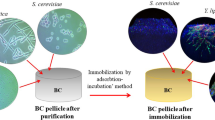Summary
Cells ofCandida tropicalis were immobilized in polyacrylamide polystyrene and aluminium alginate. These preparations were used for the degradation of phenol. The relative rate of phenol oxidation of immobilized cells was 28% as compared with suspended cells.
Similar content being viewed by others
References
Dunlop,R.B. (1974). Immobilized Biochemicals and Affinity Chromatography, New York-London: Plenum Press
Hackel,U. (1974). Modellversuche zur Polymerfixierung von Mikroorganismen Diplomarbeit, TU Braunschweig
Tosa,T., Sato,T., Moni,T., Chibata,I. (1974). Applied Microbiology27, 886–889
Neujahr,H.Y. (1972). Phenol degrading enzymes from yeast. Fermentation Technology Today G.Terui (ed), Japan: Society of Fermentation Technology
Thiele,H., Cordes,J. (1967). Kolloid-Z. u. Z. Polymere,216–217, 361–370
Author information
Authors and Affiliations
Rights and permissions
About this article
Cite this article
Hackel, U., Klein, J., Megnet, R. et al. Immobilisation of microbial cells in polymeric matrices. European J. Appl Microbiol. 1, 291–293 (1975). https://doi.org/10.1007/BF01382687
Received:
Issue Date:
DOI: https://doi.org/10.1007/BF01382687




